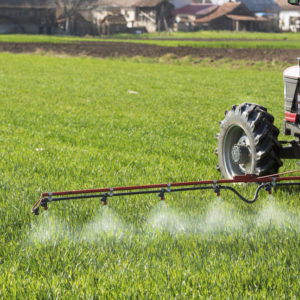130 lbs. of Roundup Sprayed Over Every Square Mile in the U.S. on Average, NBC News Reports
Iowa, Illinois and Indiana were the three states where Roundup was most heavily used, according to the findings

A new investigative report highlights the widespread use of the controversial weed killer Roundup, which has been linked to an increased risk of cancer and other side effects, indicating that 130 pounds of the herbicide is sprayed per square mile in the United States, with Iowa, Illinois and Indiana seeing the most usage.
In 2015, the World Health Organization’s International Agency for Research on Cancer (IARC) decided to classify glyphosate in Roundup as a probable cancer-causing agent, and direct exposure to the weed killer has been linked to reports of non-Hodgkin’s lymphoma.
As a result of Monsanto’s failure to disclose that risk associated with exposure to the widely marketed weed killer, the company has faced tens of thousands of Roundup lawsuits, which uncovered internal documents that highlighted how the company has covered up negative findings associated with glyphosate for decades, and manipulated study results involving the widely used weed killer.

Learn More About
Exposure to RoundUp May Increase Risk of Non-Hodgkins Lymphoma and Other Cancers. Lawsuits Reviewed Nationwide.
Learn More About this Lawsuit See If You Qualify For CompensationIn an NBC news report published earlier this month, investigators analyzed the use of Roundup and its active ingredient, glyphosate, across American crops and fields. They used data from the U.S. Geological Survey collected in 2019, and found an average of almost 130 pounds of glyphosate is used per square mile across the U.S. NBC News analysts then created a Roundup exposure map, showing the areas of the U.S. with the greatest usage.
The data indicates Nueces County, Texas, had the highest glyphosate use of any county in the country, with more than 1,100 pounds used per square mile. However, Iowa, Illinois and Indiana were the states where Roundup was most widely used overall. Iowa and Illinois, home to most of the nation’s corn and soybean crops, accounted for 15% of the nation’s Roundup use, according to the findings.
Roundup was used the least in the Southwestern and Northwestern states, the investigation determined.
Roundup Exposure Side Effects
Living in a county with widespread Roundup use did not necessarily lead to increased Roundup exposure risks, according to the findings. The biggest exposure risks were for farm workers and gardeners who directly use Roundup, those who live near farms or manufacturing facilities where it is made, and for those who live near hazardous waste disposal sites where the chemicals are dumped.
For most of the population, Roundup exposure comes from eating or handling food or water treated with Roundup.
A study published in September by the consumer activist group Moms Across America found that more than 95% of school lunches tested positive for detectable levels of glyphosate. The study also found the lunches often contained heavy metals and hormones.
In another study, published in Environmental Health earlier this month, researchers found detectable levels of glyphosate in the urine of 99% of all pregnant women. Researchers found that newborn birth weight percentiles were negatively affected related to the amount of glyphosate detected in the mother’s urine. Women with high glyphosate levels in the first trimester are 16% more likely to have a child who needed to be admitted to NICU.
Roundup Lawsuits Over Glyphosate Risks
Following the release of other studies which highlighted the risk of non-Hodgkin’s lymphoma from glyphosate, thousands of Roundup lawsuits have been brought against Monsanto in recent years, each raising similar allegations that the manufacturer failed to adequately warn about the cancer risks associated with glyphosate and manipulated studies to avoid regulations that would limit use of the weed killer.
Following several years of litigation and massive verdicts returned in a number of early trials, Bayer and its Monsanto subsidiary have agreed to pay billions in Roundup settlements for former users diagnosed with non-Hodgkin’s lymphoma, and the companies are expected to continue to face claims over the glyphosate-based weed killer for years to come.
In response to the growing concerns and massive verdicts, the manufacturer announced plans last year to remove glyphosate from Roundup versions of the weed killers sold to U.S. residential customers by 2023. The products would still be sold under the Roundup label, but would use a different active ingredient, which has not been linked to a risk of non-Hodgkin’s lymphoma and other side effects. However, glyphosate would still be used in products sold to agricultural businesses and farmers, and in products sold in other parts of the world.
Get more articles like this sent directly to your inbox.
"*" indicates required fields






0 Comments